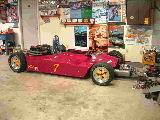Super Vee started with the SCCA Gold Cup series in 1971. These cars were based on the air-cooled VWs of the era. Startlingly quick for cars with production-based engines, they were quickly outshone when the first water-cooled Super Vees came on the scene in 1978, the same year that USAC introduced the Mini-Indy series that supported Indy Cars. With the switch to the water-cooled VW engines the '78 Mini-Indy series was a wide-open field of new chassis. That first year was dominated by the Lola 620 and the Argo JM-2, which won both the Gold Cup and the Mini-Indy series for Bill Alsup. In 1979 the first of the Ralts was introduced, the legendary RT-1. Unfortunately when CART was formed and the Indy Cars were pulled away from USAC, the Mini-Indys died on the vine. By 1983 or '84 the RT-5 totally dominated the Gold Cup series. RT-5s still run today as Formula Atlantics, nearly 20 years later! Among the new contenders in the seminal 1978 season was the Wheeler, designed and built by Dan Gurney's team designer. The first seven Wheelers were built before the start of the season. With a full monocoque chassis, they were sophisticated compared to the early air-cooled Super Vees. The Mini-Indy Super Vees were a quantum leap beyond their air-cooled predecessors. The Wheeler was a typical example. The car weighed 960 pounds in race trim, although it weighs closer to 1000 pounds today. Its 1.6 liter Rabbit engine made 170 horsepower, good for a top speed of 170 mph with proper gearing. On the tighter circuits such as Long Beach they were actually faster than their Indy Car big brothers. Although the Wheeler was an excellent design, the Ralt RT-1 dominated the series, and production of Wheelers ended after only ten were built. Tom's car, chassis number 8, was born in September 1978, months after its first seven siblings. Its history in the USAC Mini-Indy series started that fall. The car's owner, Fred Carillo, of Carillo Rods fame, hired Pete Halsmer to pilot the car. The car ran only three races in 1978, but in 1979 Halsmer took it to a fourth place overall in the series. This summer Tom met Pete, who generously autographed the Wheeler's wing. After the 1980 season the Wheeler competed in the 1981 and '82 USAC Gold Cup series. It then sat in the trailer from 1983 until Tom bought the car in 1997. The trailer itself is a true vintage collectable with a story of its own. It was originally used by A.J. Foyt for his late '60's Indy car. That it's a super-light trailer for an individual car just goes to show how much the sport has changed in the intervening years. Fully enclosed and aerodynamic, it's a dream to tow. It was nicknamed the "Watson Coffin," after its shape and its designer, the venerable A.J. Watson. |
Super Vee started with the SCCA Gold Cup series in 1971. These cars were based on the air-cooled VWs of the era. Startlingly quick for cars with production-based engines, they were quickly outshone when the first water-cooled Super Vees came on the scene in 1978, the same year that USAC introduced the Mini-Indy series that supported Indy Cars. With the switch to the water-cooled VW engines the '78 Mini-Indy series was a wide-open field of new chassis. That first year was dominated by the Lola 620 and the Argo JM-2, which won both the Gold Cup and the Mini-Indy series for Bill Alsup. In 1979 the first of the Ralts was introduced, the legendary RT-1. Unfortunately when CART was formed and the Indy Cars were pulled away from USAC, the Mini-Indys died on the vine. By 1983 or '84 the RT-5 totally dominated the Gold Cup series. RT-5s still run today as Formula Atlantics, nearly 20 years later! Among the new contenders in the seminal 1978 season was the Wheeler, designed and built by Dan Gurney's team designer. The first seven Wheelers were built before the start of the season. With a full monocoque chassis, they were sophisticated compared to the early air-cooled Super Vees. The Mini-Indy Super Vees were a quantum leap beyond their air-cooled predecessors. The Wheeler was a typical example. The car weighed 960 pounds in race trim, although it weighs closer to 1000 pounds today. Its 1.6 liter Rabbit engine made 170 horsepower, good for a top speed of 170 mph with proper gearing. On the tighter circuits such as Long Beach they were actually faster than their Indy Car big brothers. Although the Wheeler was an excellent design, the Ralt RT-1 dominated the series, and production of Wheelers ended after only ten were built. Tom's car, chassis number 8, was born in September 1978, months after its first seven siblings. Its history in the USAC Mini-Indy series started that fall. The car's owner, Fred Carillo, of Carillo Rods fame, hired Pete Halsmer to pilot the car. The car ran only three races in 1978, but in 1979 Halsmer took it to a fourth place overall in the series. This summer Tom met Pete, who generously autographed the Wheeler's wing. After the 1980 season the Wheeler competed in the 1981 and '82 USAC Gold Cup series. It then sat in the trailer from 1983 until Tom bought the car in 1997. The trailer itself is a true vintage collectable with a story of its own. It was originally used by A.J. Foyt for his late '60's Indy car. That it's a super-light trailer for an individual car just goes to show how much the sport has changed in the intervening years. Fully enclosed and aerodynamic, it's a dream to tow. It was nicknamed the "Watson Coffin," after its shape and its designer, the venerable A.J. Watson. |
Wheeler Super Vee |

